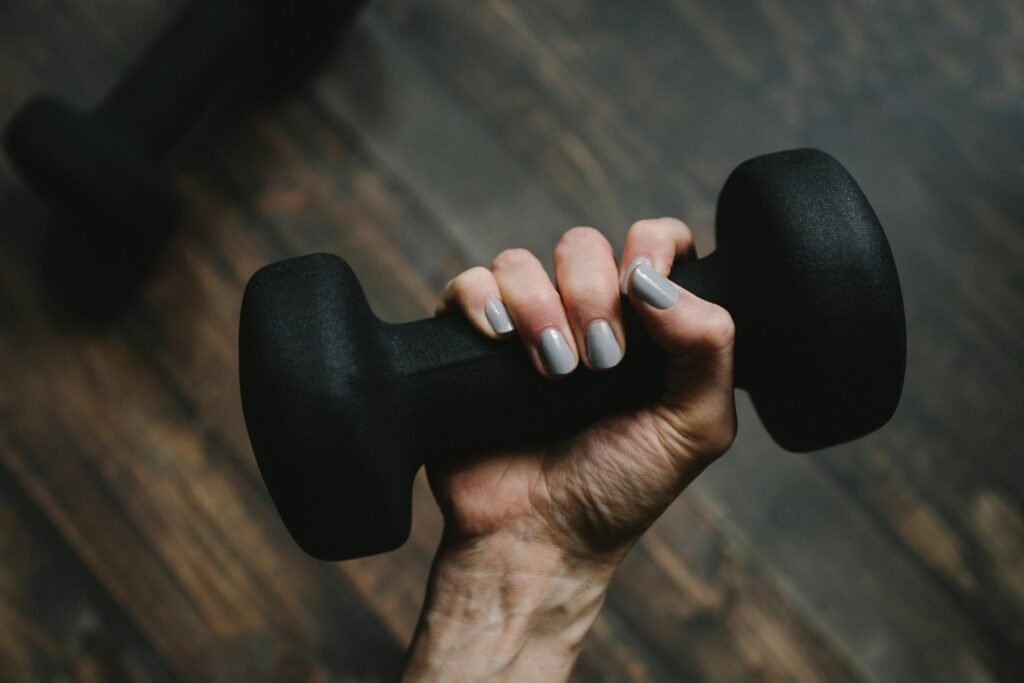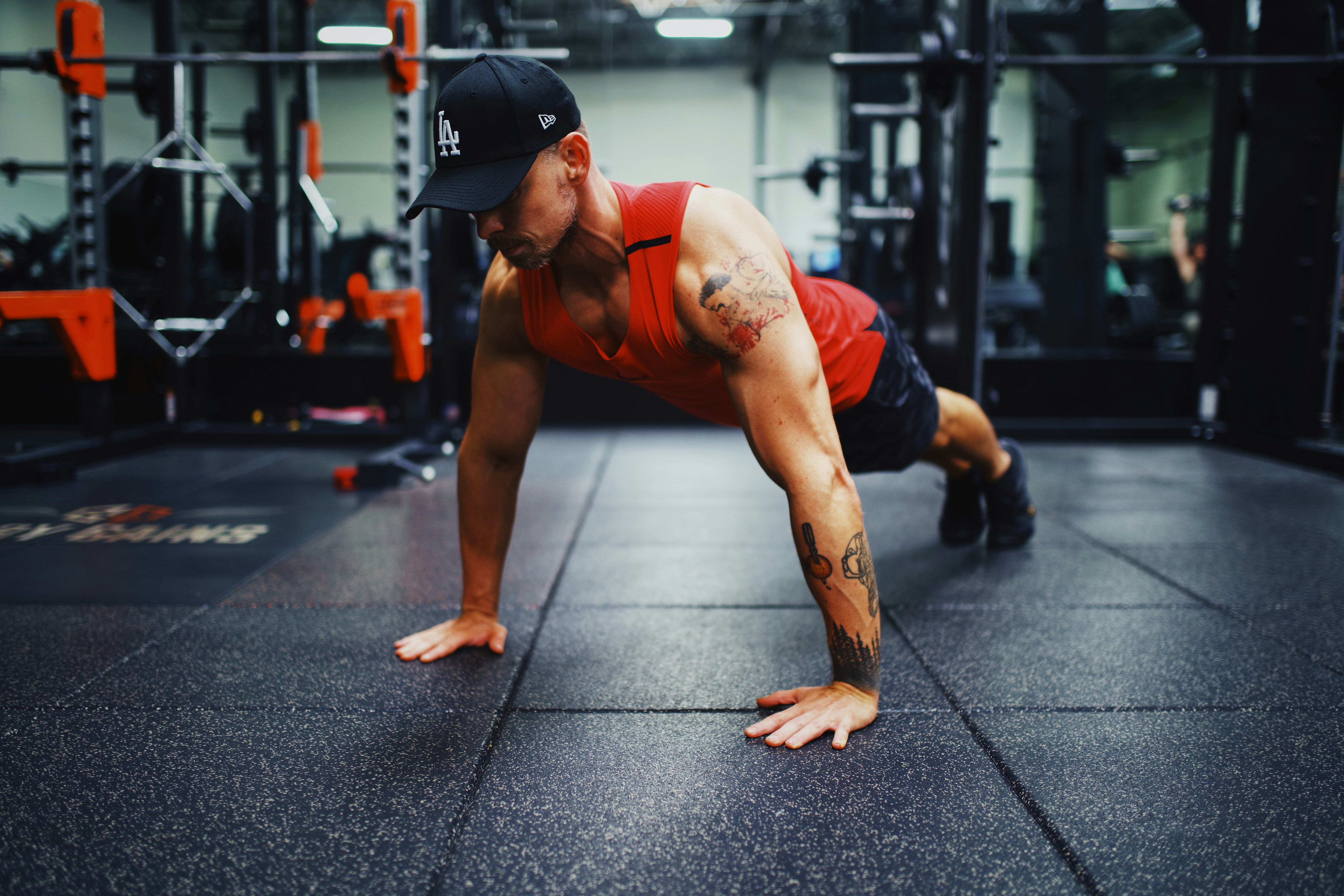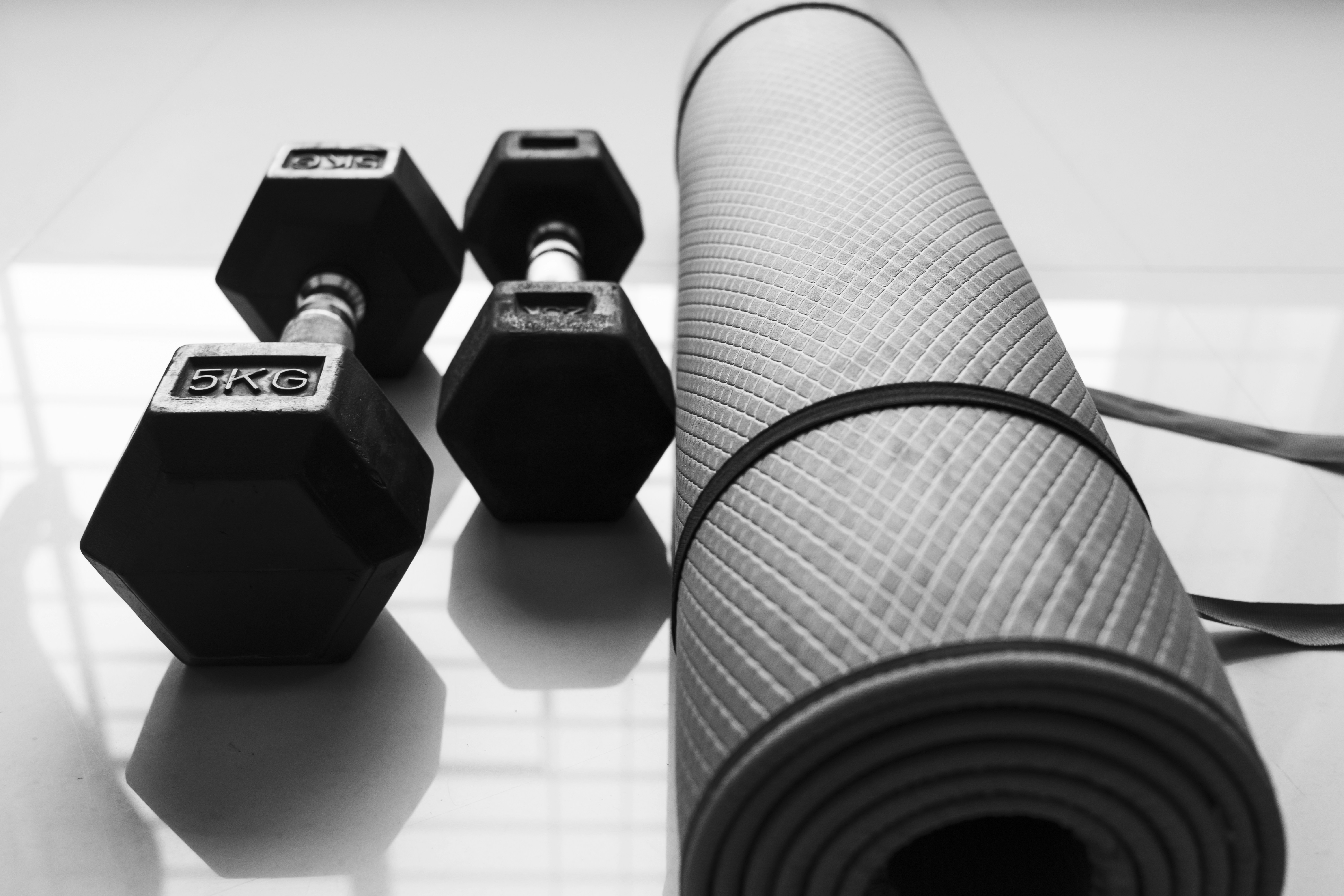
Photo by Kelly Sikkema on Unsplash
Dumbbell workouts without a bench can be highly effective for building muscle and strength, offering a range of benefits that might surprise you. Firstly, these exercises can save you money and space. A bench is often a pricey investment and can take up significant room in your home gym. By skipping the bench, you can create a more cost-effective and compact workout area.
Moreover, working out without a bench forces your body to engage more stabilizing muscles. When performing exercises like floor presses or push-ups with dumbbells, your core and lower body have to maintain stability, resulting in a more comprehensive workout. This broader muscle engagement can lead to greater overall functional strength.
Statistics show that using free weights can significantly increase muscle activation compared to machine-based exercises. For example, a study published by the American Council on Exercise found that the dumbbell bench press activates 15% more muscle fibers than the barbell bench press [^1^].
Additionally, dumbbell workouts without a bench are convenient and versatile. You can easily adapt these workouts to various fitness levels and goals. Whether you’re aiming to build muscle, improve endurance, or enhance functional fitness, you can tailor dumbbell exercises to meet your needs without relying on a bench.
Lastly, these workouts are effective for people of all fitness levels. Whether you’re a seasoned athlete or just starting out, you can benefit from the simplicity and versatility of dumbbell exercises done on the floor. Plus, this approach is easier on the joints, as it limits the range of motion to a safer, more controlled level.
By incorporating these exercises, you can achieve a well-rounded fitness routine without the need for a bench. For example exercises, you can explore our detailed guide on 11 Dumbbell Chest Exercises Without a Bench.
[^1^]: American Council on Exercise Study
Why Choose Dumbbells for Chest Workouts?
Dumbbells are a fantastic option for chest workouts, offering multiple benefits over other equipment like barbells. One key advantage is the promotion of muscle symmetry. When using a barbell, it’s easy for one side of the body to work harder, leading to imbalances. In contrast, dumbbells involve each arm working independently, ensuring both sides exert the same effort (Source).
Stabilization is another important factor. Dumbbells require more use of stabilizing muscles, making your workouts more effective. This means more muscle fibers are engaged, providing a more comprehensive workout for your chest muscles. For example, your shoulders and elbows have to stabilize the weights, which isn’t the case with a barbell press where the bar limits this necessity (Source).
Additionally, dumbbells offer a greater range of motion, allowing for better targeting of different parts of the chest. Because each side of your body operates independently, you can adjust your movements to focus on specific muscle fibers more easily than you can with a barbell. This is especially useful if you want to shape and define your chest muscles more precisely.
Lastly, dumbbells are often safer for solo workouts. If you lift heavy weights without a spotter, getting trapped under a barbell can be dangerous. Dumbbells eliminate this risk because you can easily drop them if you get stuck.
Choosing dumbbells for chest workouts enhances muscle symmetry, engages stabilizing muscles, offers a greater range of motion, and provides a safer workout option.
Warm-Up: Preparing Your Chest for Exercise

Photo by Gordon Cowie on Unsplash
Warming up is a crucial step before diving into any chest workout. A proper warm-up can improve performance and significantly reduce the risk of injury. Here is a routine that targets the arms, shoulders, back, and chest to get you ready for an effective workout.
1. Arm Swings
Dynamic stretches like arm swings increase blood flow and flexibility in your arms, shoulders, and upper back. To perform arm swings:
- Stand up straight with your feet shoulder-width apart.
- Lift your arms to shoulder height.
- Swing your arms forward until they cross in front of you.
- Swing them back to the starting position.
Repeat this motion 10-15 times. For an extra challenge, do a second set of arm swings in the reverse direction. Dynamic stretches are especially beneficial before a workout because they enhance your range of motion and get your muscles ready for action ^1^.
2. Push-Ups
Push-ups are an excellent warm-up exercise because they activate the chest, shoulders, and arms. Here’s how to perform them correctly:
- Assume a plank position with your hands shoulder-width apart.
- Lower your body while keeping your back straight.
- Before touching the ground, push yourself back up to the starting position.
Start with two sets of 5-10 reps. To increase difficulty, you can vary your push-ups by using a medicine ball or doing them at an incline ^2^.
3. Dumbbell Chest Fly
Adding some light weights with a dumbbell chest fly can further prepare your chest for the workout.
- Lie flat on the floor with a weight in each hand.
- Extend your arms above your chest.
- Slowly lower the weights to your sides, keeping a slight bend in your elbows.
- Raise the weights back to the starting position.
Aim for sets of 10-15 reps. This exercise helps activate your chest and triceps, making it easier to handle more intense lifts later.
Warming up properly ensures that you’re setting the stage for a safe and effective workout. For more insights into fitness routines, check out our guide on low-impact cardio workouts.
[^1^]: Cleveland Clinic. Understanding the Difference Between Dynamic and Static Stretching. [^2^]: Best Health Magazine. How to Do Push-Ups Properly.
Top Dumbbell Chest Exercises Without a Bench
If you have dumbbells but no bench, you can still engage in an effective chest workout. Here are some of the best exercises you can try:
- Standing Dumbbell Upward Fly
- How to do it: Stand with your feet hip-width apart and hold dumbbells with an underhand grip. Lift the dumbbells up to shoulder height, contracting your chest until the weights meet in the center. Slowly lower to the starting position.
- Muscles targeted: Mid and upper chest, front delts, triceps, biceps.
- Dumbbell Floor Chest Press
- How to do it: Lie on your back with knees bent and feet on the floor. Hold dumbbells with an overhand grip. Start with your arms bent, triceps on the ground. Push the dumbbells up until your arms are fully extended, then return to the starting position.
- Muscles targeted: Chest, triceps, rhomboids, serratus anterior.
- Standing Dumbbell Svend Chest Press
- How to do it: Stand with your feet hip-width apart, holding a dumbbell with both hands clasped around it vertically. Press your hands together as much as possible, then push the dumbbell upward and inward slowly until your arms are straight. Return to the starting position.
- Muscles targeted: Chest, triceps, front delts, serratus anterior.
- Dumbbell Single Arm Floor Fly
- How to do it: Lie on your back with legs extended. Hold a dumbbell with a neutral grip and start with your arm out perpendicular, elbow slightly bent. Contract your chest to lift the dumbbell up until it’s directly above your shoulder, then return to the starting position.
- Muscles targeted: Chest, front delts, serratus anterior, biceps.
- Dumbbell Floor Hammer Press
- How to do it: Lie on your back with knees bent and feet flat on the floor. Hold dumbbells with a neutral grip. Press the dumbbells up until your arms are fully extended, then return to the starting position.
- Muscles targeted: Chest, triceps, front delts, biceps.
- Dumbbell Floor Alternating Chest Press
- How to do it: Lie on the ground with legs extended. Hold dumbbells with an overhand grip. Alternate pressing each dumbbell up until your arm is fully extended, then return to the starting position.
- Muscles targeted: Chest, triceps, rhomboids, serratus anterior.
These exercises can provide an intense workout and help build a strong chest. For more in-depth variations, check out our at-home dumbbell back workout to complement your chest routine.
Reference:
How to Structure Your Workout Routine

Photo by VD Photography on Unsplash
Structuring a workout routine for dumbbell chest exercises without a bench requires strategic planning. Here’s a step-by-step guide to help you get the most out of your workouts:
- Frequency of Training: Decide how often you will work out each week. For beginners, starting with three sessions per week is beneficial. Follow a schedule that allows for muscle recovery while still promoting strength gains.
- Duration of Workout: Aim for 30 to 45-minute sessions if you’re just starting. With experience, you can extend this to 60 minutes. Shorter workouts can be highly effective if you focus on maintaining high intensity throughout.
- Target Areas: Even without a bench, you can target various parts of your chest. Include exercises like dumbbell floor presses, standing chest flys, and push-ups. Plan to work on different parts of your chest and adjust every few weeks to prevent plateaus.
- Exercise Intensity: Use moderate weights, especially if you are a beginner. The goal is to focus on form and controlled movements. As per the ISSA guidelines, you should never lift the maximum weight every session but gradually increase intensity to avoid injury.
- Exercise Volume: Start with 3 sets of 8-12 reps for each exercise. Over time, adjust the weight and number of sets as your strength improves. For instance, lifting a 20-pound dumbbell for 3 sets of 12 reps is a good start. Increase this weight gradually based on your progress.
Finally, ensure that each workout includes a warm-up and cooldown phase. Begin with 5-10 minutes of light cardio or dynamic stretching to prep your muscles. End with static stretches to aid recovery and minimize soreness. For tips on effective cardio, check out our resource on low-impact cardio.
Remember, consistency and gradual progression are keys to success in any workout routine.
Advanced Techniques to Intensify Your Workout
Consider incorporating advanced training techniques to make your dumbbell chest workouts without a bench more challenging. These methods can help break through plateaus and increase the effectiveness of your workouts. Here are some techniques to try:
- Drop Sets: Perform an exercise to failure, then reduce the weight and continue the set. This method can significantly increase muscle fatigue and growth. For instance, start with a heavier pair of dumbbells for chest presses, then switch to lighter ones without resting.
- Supersets: Combine two exercises back-to-back with minimal rest. An example could be performing push-ups immediately followed by dumbbell flys. According to a study, supersets can increase workout efficiency by reducing rest times while maintaining intensity (Strength and Conditioning Course).
- Tempo Training: Slow down the tempo of each rep to increase time under tension. For example, lower the dumbbells slowly over a 4-second count and lift them over 1-2 seconds. This technique can enhance muscle growth and endurance.
- Pyramids: Start with a lighter weight and higher repetitions, then gradually increase the weight while reducing the reps. This method can help build both strength and muscle endurance. For example, perform 12 reps with a light weight, 10 reps with a slightly heavier weight, and continue until you reach your maximum.
- Negatives: Focus on the eccentric, or lowering phase of the exercise. Use a heavier weight than usual and lower it slowly, then have a partner help you lift it back up. This method can lead to significant muscle hypertrophy due to the increased muscle tension during the lowering phase.
- Pauses: Add a pause at the hardest part of the lift, such as the bottom of a dumbbell press. Holding this position for 2-3 seconds can increase muscle activation and strength.
Incorporating these advanced techniques into your workout routine can be a game-changer, making each session more productive and helping you reach your fitness goals faster. Want to know more about structuring your workouts effectively? Check out our detailed guide on how much cardio should I do a week when trying to build muscle.
Reference:
Recovery and Stretching Tips for Chest Workouts
Recovery is crucial for making progress with chest workouts. Post-workout stretching and proper cooldown routines help prevent muscle soreness and improve flexibility. Stretching the pectoral muscles, anterior deltoids, and biceps can minimize the risk of injuries and enhance your range of motion.
One effective stretch is the Behind-the-Back Elbow-to-Elbow Grip. It’s simple to perform either seated or standing. Start with your arms hanging by your sides, shoulders relaxed. Bring the arms behind your back and grip elbow to elbow, squeezing your shoulder blades together to broaden the chest.
Another beneficial stretch is the Above-the-Head Chest Stretch. This can also be done seated or standing. Interlock your fingers behind your head, then squeeze your shoulder blades together and move your elbows backward. This stretch can be varied by positioning your hands higher or lower.
The Bent-Arm Wall Stretch targets each side of your chest separately. Stand in a split stance near a wall. Place your arm against the wall, with your elbow bent at 90 degrees and press your chest forward to stretch.
According to ACE Fitness, holding each stretch for 10-30 seconds and repeating 2-4 times can yield significant improvements in flexibility.
For an alternative focus on active recovery, engaging in low-impact cardio such as walking or cycling can help maintain blood flow and aid muscle recovery (see: low-impact cardio).
Incorporating these simple yet effective stretches and recovery methods into your routine can promote muscle healing, reduce soreness, and improve overall performance in your chest workouts.